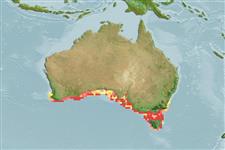Actinopterygii (ray-finned fishes) >
Ophidiiformes (Cusk eels) >
Ophidiidae (Cusk-eels) > Ophidiinae
Etymology: Genypterus: Greek, geny, -yos = face, jaw + Greek, pteron, = wing, fin (Ref. 45335). More on author: Klunzinger.
Environment / Climate / Range
Ecology
Marine; brackish; demersal; depth range 0 - 60 m (Ref. 33847). Subtropical, preferred ?; 32°S - 44°S, 114°E - 151°E (Ref. 34024)
Southwest Pacific: southern Australia and New Zealand.
Size / Weight / Age
Maturity: Lm ? range ? - ? cm
Max length : 120 cm SL male/unsexed; (Ref. 34024)
Short description
Morphology | Morphometrics
Uncommon and benthic species in rocky habitat (Ref. 34024). Restricted to estuaries, shallow bays and coastal reefs (Ref. 33847). Found on the continental shelf and slope (Ref. 75154). Juveniles are found in seagrass beds in estuaries while adults inhabit caves and rocky recesses (Ref. 33847). Oviparous, with oval pelagic eggs floating in a gelatinous mass (Ref. 205). Important as a recreational fish (Ref. 33839). Minimum depth reported taken from Ref. 57178.
Life cycle and mating behavior
Maturity | Reproduction | Spawning | Eggs | Fecundity | Larvae
Nielsen, J.G., D.M. Cohen, D.F. Markle and C.R. Robins, 1999. Ophidiiform fishes of the world (Order Ophidiiformes). An annotated and illustrated catalogue of pearlfishes, cusk-eels, brotulas and other ophidiiform fishes known to date. FAO Fish. Synop. 125(18):178p. Rome: FAO. (Ref. 34024)
IUCN Red List Status (Ref. 115185)
CITES (Ref. 94142)
Not Evaluated
Threat to humans
Harmless
Human uses
Fisheries: minor commercial
More information
Age/SizeGrowthLength-weightLength-lengthLength-frequenciesMorphometricsMorphologyLarvaeLarval dynamicsRecruitmentAbundance
ReferencesAquacultureAquaculture profileStrainsGeneticsAllele frequenciesHeritabilityDiseasesProcessingMass conversion
Tools
Special reports
Download XML
Internet sources
